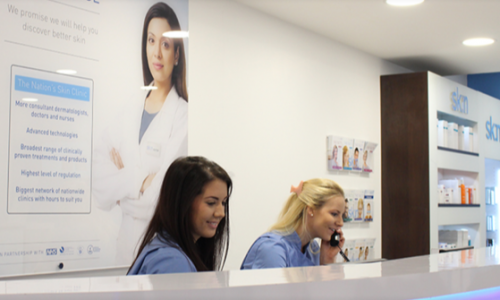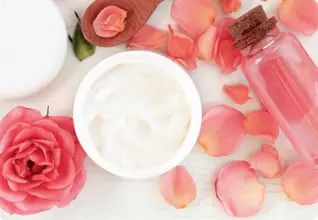Rosacea or redness?

Redness and rosacea are similar conditions and knowing which one you suffer from can help you find a long term treatment solution and start taking preventative measures to avoid future flares.
We have outlined everything you need to know about the differences and similarities between redness and rosacea, so that you can identify whether your redness is temporary or the sign of a more permanent skin condition.
How to know if you have rosacea
Rosacea is a chronic skin condition that causes a flushed appearance across your nose, cheeks and forehead. Unfortunately, rosacea is an incurable condition with its occurrence still a mystery, however it can be managed significantly.
Rosacea can affect women more than men and commonly occurs in the 30s-40s, yet early rosacea can start in your 20s.
If you are wondering “do I have rosacea?”, these are the signs and symptoms to look out for. People with rosacea have identified that the first, early symptoms of rosacea were:
- Itchy and tight skin
- Increased flushing and blushing
- Frequent eye infections
- Burning or stinging feeling when using water or skincare products
- Skin sensitivity to sun exposure
Above are the early stage rosacea symptoms, however as the condition develops over time, the symptoms worsen. Long term symptoms can be:
- Developing of pus filled spots, pink and hard bumps (acne rosacea)
- Persistent redness and soreness
- Visibility of broken blood vessels that do not go away
- Swelling and thickening of the nose
- Dry, sore eyes
- Lip and eye problems
If you experience any of these symptoms, you can speak to one of our qualified dermatologists or your doctor who can help you manage any symptoms experienced.
Rosacea treatments
The professional facial treatments we offer can help persistent redness and works to visibly reduce the signs of rosacea.
-
Laser treatment
Facial thread vein treatment works to reduce the appearance of enlarged, broken and visible blood vessels. As broken blood vessels are the cause of redness, this treatment will help restore your natural complexion. It employs an intense pulsed light from a hand held laser device to target and dissolve any prominent facial vessels.
-
Chemical peels
Chemical peels are non-invasive treatments containing active ingredients to help treat uneven pigmentation and acne rosacea. Skin peels have rejuvenating qualities and can reduce inflammation and redness. They are suitable for sensitive skin and leave your skin visibly brighter whilst encouraging a stronger skin barrier.
Other treatments can be oral antibiotics. It is best to avoid over-the-counter medications and creams as scented, oil-based and alcohol-based products can worsen the condition.
How to know if you have redness
Facial redness is often temporary, which is the main difference between rosacea and redness. If you have persistent flushing but do not display any of the other symptoms of rosacea, you may be suffering from a mild form of the condition.
Redness can also occur if you’re experiencing an allergic reaction to food, skincare products, medication or washing powder.
Certain hormonal states, such as pregnancy and menopause, can also increase your proneness to blushing and hot flushes. Intense exercise and drinking alcohol may also lead to enlarged facial blood vessels.
Similarly to rosacea, facial redness can be treated using the same treatments to restore your natural appearance. Laser treatment is less suitable for facial redness, unless the problem is persistent.
Choosing a skin rejuvenating treatment instead is recommended and can help restore a natural, even complexion and reduce any flushing. Some of the treatments are:
Preventing rosacea and redness
Early sufferers of rosacea noticed that a flare was triggered by sun exposure, spicy foods, alcohol, stress, skincare products and extreme temperature fluctuations. Others noticed that their outbreaks can appear in cycles.
The first step to prevent redness is to become aware of your own triggers and cycles and protect your skin from facing them if they are unavoidable.
Certain lifestyle changes such as wearing a high SPF daily and protecting your face with a scarf during colder months may help to lessen uncontrollable redness.
Rethinking your relationship with alcohol, as it dilates the facial blood vessels, may also be necessary if you notice a correlation between your skin and alcohol consumption.
Spicy foods are a common trigger for rosacea flare ups, where almost 80% of people reported that cayenne pepper affected their rosacea. Red pepper, jalapenos and hot sauces also worsened their symptoms.
Capsaicin is the active component found in chili peppers and when it comes into contact with the skin, it causes a mild irritant effect, producing the burning sensation experienced when you eat something spicy.
This stimulates the body’s pain receptors and causes a warming, hot feeling. As sufferers of rosacea may be more sensitive to heat, this can cause the blood to rush to the surface, aggravating the already broken blood vessels.
Skincare products and stress can also impact redness and rosacea. As people with rosacea experience tingling and burning when applying certain cosmetics, it is best to avoid any harsh chemicals and simplify your regime.
Alternatively, finding natural formulas and makeup products that are as gentle as possible, unscented and water-based, may also help to minimise any aggravated episode of redness.
Taking time for yourself and participating in self care routines can also help to improve your overall well-being and potential redness, as stress weakens the immune system, it makes you more vulnerable to inflamed skin and rashes which can exacerbate rosacea and redness.
Key takeaways
- Rosacea is a chronic condition that cannot be cured but significantly managed
- Redness is often temporary and can be due to allergic reactions or hormonal changes
- Laser treatments, professional skin peels and facials can help to reduce redness across the face
- Knowing your triggers can help you prevent a future outbreak
- Arrange a consultation with one of our dermatologists for advice on how to manage redness and rosacea
Related Articles

08
Apr 2024

08
Apr 2024
Request a callback
One of our friendly sk:n advisors will call you to book your consultation.
- More than 450 consultants, doctors, nurses and medical practitioners
- Regulated by the Care Quality Commission, Health Inspectorate Wales and Health Improvement Scotland
- Partner of the NHS
- Rated excellent by our clients on Trustpilot
- Strict safety and care protocols




